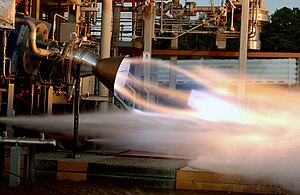RS-88
 An RS-88 is fired at Stennis Space Center | |
| Country of origin | United States |
|---|---|
| Manufacturer | Aerojet Rocketdyne |
| Application | Developed into an abort motor for the CST-100 Starliner |
| Status | Active |
| Liquid-fuel engine | |
| Propellant | Liquid oxygen / Ethanol or MMH / NTO (LAE variant) |
| Performance | |
| Thrust | 220 kN (ethanol) or 176.6 kN (hypergolic) |
| Used in | |
| CST-100 Starliner | |
The RS-88 is a liquid-fueled rocket engine burning ethanol as fuel, and using liquid oxygen (LOX) as the oxidizer. It was designed and built by Rocketdyne, originally for the NASA Bantam System Technology program (1997).
In 2003, it was designated by Lockheed for their pad abort demonstration (PAD) vehicle. NASA tested the RS-88 in a series of 14 hot-fire tests, resulting in 55 seconds of successful engine operation in November and December 2003. The RS-88 engine proved to be capable of 50,000 lbf (220 kN) of thrust at sea level.
A hypergolic derivative of the RS-88 has been selected for the Boeing CST-100 Starliner launch escape system.[1] This version is capable of 39,700 lbf (176.6 kN) of thrust and four are used in Starliner's abort system.[2]
Bantam Launch System[edit]
The Bantam System Technology Project, which is part of the Low Cost Technologies effort, teams NASA and its business partners to research and demonstrate technologies for a new low-cost launch system. A technology demonstration flight was targeted for late 1999.[3]
The RS-88 engine was designed by Rocketdyne under NASA's Bantam program[4] which was the propulsion element of the low-cost technologies of the larger Advanced Space Transportation Program.
Boeing CST-100[edit]

The launch escape system for Boeing's CST-100 spacecraft uses a lightweight, hypergolic derivative of the RS-88 called the Launch Abort Engine (LAE).[5]
See also[edit]
References[edit]
- ^ "Test of Rocketdyne abort motor for Boeing crew capsule". youtube.com. Retrieved 24 November 2011.
- ^ Clark, Stephen. "Aerojet Rocketdyne wins propulsion contracts worth nearly $1.4 billion – Spaceflight Now". Retrieved 2019-12-19.
- ^ "Low Cost Technologies" (Press release). NASA. June 1997. Archived from the original on 2010-02-16. Retrieved 2012-06-01.
- ^ "NASA Selects Four Companies to Demonstrate Low Cost Launch System Technologies" (Press release). NASA. June 9, 1997. Release C97. Archived from the original on November 20, 2011.
- ^ "PWR Analyzing Hot-Fire Tests For CST-100 Launch Abort Engine". beyondearth.com. Archived from the original on 23 September 2015. Retrieved 5 September 2015.

